

Home
The Mission
Parts of Mission San Miguel have been rebuilt - starting with the fire of 1806 - several times. After the illegal seculariztion of Mission lands by the Mexican Government in 1833, Mission San Miguel was neglected for 36 years. The recovery of Mission San Miguel and the first major rebuilding program began with the return of Father Philip Farrelly in 1879.
The Earthquake of December 22nd, 2003 has caused damage to the old Mission Church, and it is closed for now to the public. A second rebuilding program to preserve the old structure has already begun.
The Lands of Mission San Miguel
Capture 25: Mission San Miguel - The later Years.
by Wallace V. Ohles
Author and Historian
After thirty-six years without a resident pastor, a priest was assigned to Mission San
Miguel in the person of Father Philip Farrelly; he
served from January 1,1879 to May 20,1886.
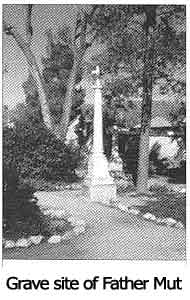 "Father
Felipe" was transferred to Mission Santa Ynez, and
was followed by Father Joseph Mut, whose period of
service was June 13, 1886 to October 30, 1889. Father
Mut is the only priest
to be buried in the
cemetery of Mission
San Miguel; he rests
there with the 2,249
Indians buried at the
mission.
"Father
Felipe" was transferred to Mission Santa Ynez, and
was followed by Father Joseph Mut, whose period of
service was June 13, 1886 to October 30, 1889. Father
Mut is the only priest
to be buried in the
cemetery of Mission
San Miguel; he rests
there with the 2,249
Indians buried at the
mission.
Father Zephyrin Engelhardt has this to say about Father Jose Mut. "To his energy is due that the row of buildings comprising the ancient Convento was preserved. Many of the rafters were decayed and others were broken, so that the roof with its heavy tiles threatened to collapse at any time. Father Mut, therefore, undertook to collect the necessary funds.
The people, delighted that their beloved landmark should be preserved, gave freely. $3,000 were secured. With this amount the energetic priest replaced the rotten timbers and broken tiles with new material, and thus rendered the rooms habitable and safe."
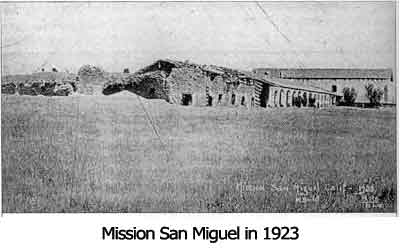 While Father Mut lived at
Mission San Miguel for three
years, he also served Mission
San Antonio to the north and
Cashin's Station and the San
Jose Valley to the south. He .
made the circuit once a month with two horses hitched
to a light wagon.
While Father Mut lived at
Mission San Miguel for three
years, he also served Mission
San Antonio to the north and
Cashin's Station and the San
Jose Valley to the south. He .
made the circuit once a month with two horses hitched
to a light wagon.
Father Mut was followed by Father Carolus Franchi (1889 to 1894), then Father Henry S. O'Reilly (1894-1889). There is a gap of time from 1889 until Father Philip J. O'Reilly's service from February 12, 1900 to March of 1903. During that gap, Rev. George Montgomery signed the Registers on June 16, 1895 and March 25, 1900.
From August 16, 1903 until August 21, 1905, Father Hugh Curran was pastor at the Mission; he was followed by Father Patrick Murphy; from August of 1905 to May of 1908. Father William Power served from June 7, 1908 until November 13, 1909; he was followed by Father William Nevin, November 1909 to September 1922.
Father Patrick Ryan served the Mission from 1922 until November of 1924. (In 1922, St. Rose of Lima parish was formed in Paso Robles.) Father Ascensio Segarra was pastor from December of 1924 until August of 1928. After 86 years of absence, the Franciscan Fathers again took charge of Mission San Miguel, on August 1, 1928.
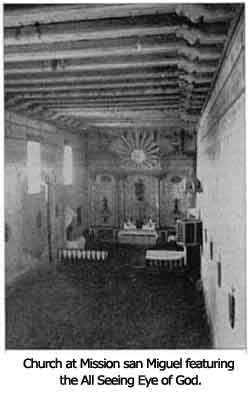 We have already seen that the mission had been
founded in 1797; the first church burned in 1806. Ten
years were spent making and storing adobe bricks to
be sure that enough were on hand when the construction of the present church was begun.
It was completed in 1818-1819. The church portion is 144 feet
long, 27 feet wide and 40 feet tall. Most of the walls
are 5 feet 10 inches thick.
We have already seen that the mission had been
founded in 1797; the first church burned in 1806. Ten
years were spent making and storing adobe bricks to
be sure that enough were on hand when the construction of the present church was begun.
It was completed in 1818-1819. The church portion is 144 feet
long, 27 feet wide and 40 feet tall. Most of the walls
are 5 feet 10 inches thick.
The mission building had been enclosed by a high adobe wall. At least two people have told of a low adobe wall extending from the Caledonia adobe to the Mission. Steve Buelna, born at the Caledonia on January 1, 1885, and Maude Viola ("Babe") Wright born at Oat Springs, on September 14, 1894, speak about walking on top of this adobe wall.
"Babe," as a young child was carrying a bucket of milk from a dairy herd near the Caledonia to her home in town. The Telfords had a dairy at the Caledonia between 1889 and 1902. On the way; she tripped and the milk was lost; she went home, dreading what the reaction would be. When she arrived, everyone in the household was upset at the news that grandfather had just died; the spilled milk was the least of their worries.
During stage-coach days, the courtyard of the mission was used to hold the stage horses. During the course of repairs in 1930, a crudely-lettered sign was uncovered on the end pillar: "Corral For Stock."
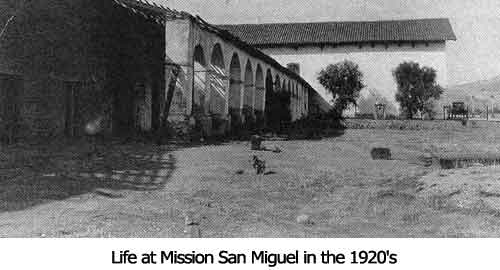
Edith Buckland Webb, who wrote Indian Life at
the Old Missions, included in some of her unpublished
material some information that had been gathered by
Eva Carpenter Iversen, a Paso Robles historian. The
following concerns a visit made in August of 1931.
The church of today was built against the front wall of the old or second church, or the front wall of the second church became part of the rear wall of the third church, which is the church now standing.The inner wall of the third church was on a line with that of the previous church, but the outer wall extends several feet beyond the outer wall of the second church. In other words, the church begun in 1816 to take the place of the church of 1798, was a bigger and better one.
This church of 1798 had 22 feet added to it, in length, in 1804. It was apparently merely a continuation of the rooms of the north wing of the quadrangle and suffered damage to its roof at the time of the {"Fire of 1806. Engelhardt stated that "The church was repaired as well as possible, but plans were made for the erection of a more spacious structure."
There was one door, near the entrance of the church on the north side which opened into the baptistery; This baptistery was the first room, or building in that long line which extended in a northeast direction from the church and formed one wing of the Indian village.
Mrs. Kate Brown, daughter of John Warth, bell-ringer at San Miguel for at least forty years as well as man-of-all-jobs, says that during Father Mut's time. . .she remembers the baptismal font which was of stone and was placed upon an adobe foundation or pedestal, set in the room adjoining the church as before stated.
In April of 1935, Mrs. Webb received information from Mrs. Kate Brown of "Morro Beach," daughter of John Warth. Among other things she said, was that "in the first little room to the right of the church was a large stone basin or bowl in which she and the other children played "fishing."
Edith Buckland Webb has written that "In the spring of 1932, we took Peter Cheney; now almost eighty years old, to visit the mission. Peter said he remembered when the first serious break was made in the north wall of the Indian village. This was made over in the northeast corner in order to have a longer track for horse-racing. The races were run over a straight-away course which was from 600 to 1200 yards in length and lay in front of the mission."
In her book, Indian Life at the Old Missions, Edith Buckland Webb states that Stephen Rios remembered a sort of "basement" which stood at the extreme front end of the front wing of San Miguel's quadrangle. She states that "Early photographs show buildings beyond those now existing at that mission buildings whose foundations have never been uncovered."
Around the same time period, Brother Benedict was rebuilding the altar. During his work, the long- sought escape tunnel was discovered. The tunnel, since fIlled in, led away to the river.
During the time of Father Mut's stay at the mission, John Warth and his two daughters were occupying a room in the Father's dwelling. Nearest the church were Father Mut's quarters, then a Doctor's office, a meat market, the Warth's, other people, then continuing along the south wing, Mexicans were living in the rooms.
Anna Nygren Hebel, writing in 1923, stated that there were twenty rooms in the southern wing of the Mission. In the small houses along the walls, the Indians had been taught various trades. Mrs. Hebel had been told by the pastor, in 1923, that as many as 2,000 Indians could gather inside the mission church. The Indians were hard to control, and instead of shaking hands to greet each other, they patted one another on the cheek. This cheek-patting by several hundred Indians made much noise; the Padres placed curtains over the windows, because the darkness frightened the Indians into silence.
In 1905, Alvin Hillis Wilmar wrote the following for the Paso Robles High School yearbook.
SONNET TO SAN MIGUEL MISSION
Methinks I see thee as thou wast of old;
Thy clay-brick walls, that many courts surround,
Rise bleak and mighty from the fruitful ground,
Making thee seem formidable and bold.
Then of thee was the happy story told,
That near thy courts was heard no profane sound,
For every soul was to the Padres bound.
The Padres with a loving hand controlled.
But now thy mighty walls lie low in waste,
Thy inmates driven from the scenes they love;
Thyself decaying, slowly; crumb by crumb.
Till stem old Time by far too much in haste,
Eats thy great timbers till they; helpless, fall,
And thou returnest to earth from whence thou'rt come.
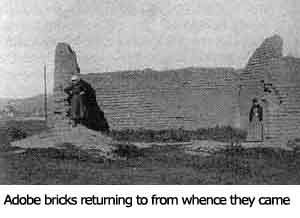
San Miguel never had a large bell tower of adobe construction. Its bells usually hung on wooden standards. The original bell, used at the dedication of the mission, was found to have a crack in it. Mission San Antonio loaned a smaller Mexican bell; it is inscribed "S. S. Gabriel A. D. 1800." This bell is suspended under the eaves of the corridor. There is also a bell that had been cast in Lima, Peru, in 1698.
During the summer of 1886, Jeff Stockdale, using his freight team, took a collection of broken bells to the end of the tracks at San Ardo. A large bell was recast, from the several mission bells, in 1888 at the Glove Bell & Brass Foundry in San Francisco. Its translated inscription reads "Blessed Michael Archangel dedicated the day before October 1888."
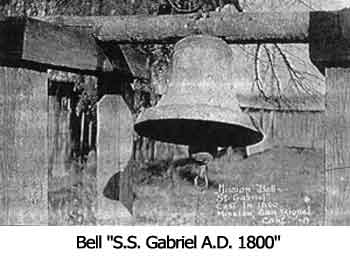 In August of 1888, a newspaper article which was
printed in the San Luis Obispo Tribune and the Daily
Republic stated that "The new brass bell for San
Miguel Mission arrived, and is at the depot. The whole
affair weighs 2,800 pounds, and cost, laid down in San
Miguel, $653. Father Mut says it will- - -or should- - -
be heard as far away as Paso Robles."
In August of 1888, a newspaper article which was
printed in the San Luis Obispo Tribune and the Daily
Republic stated that "The new brass bell for San
Miguel Mission arrived, and is at the depot. The whole
affair weighs 2,800 pounds, and cost, laid down in San
Miguel, $653. Father Mut says it will- - -or should- - -
be heard as far away as Paso Robles."
In October of 1888, the newspaper reported that "Father Mut furnishes a financial statement of work, from which it seems that there was raised for the purchase of the bell from individual subscriptions $521.15; from the proceeds of the sale of the old bells from San Luis Mission, about which we gave a detailed account some months since, $87.20; and from the Ladies' Fair $289.25 (for) a total of $898.25. The new bell cost, with incidental expenses, is exactly $700 and the balance left, with such moneys as may be raised later, is to be applied to the erection of a suitable belfry;"
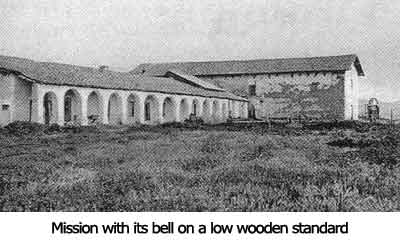 The bell was hung in a low wooden tower, directly
in front of the mission; later, the tower and bell were
moved to the south side of the mission church. When
the bell was on the short tower, and situated in front of
the church, Ella Adams says "Its mellow tones, echoing against the mission church, could be heard five
miles away;"
The bell was hung in a low wooden tower, directly
in front of the mission; later, the tower and bell were
moved to the south side of the mission church. When
the bell was on the short tower, and situated in front of
the church, Ella Adams says "Its mellow tones, echoing against the mission church, could be heard five
miles away;"
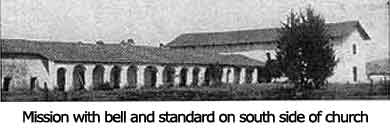 A steel tower was sent out from Chicago, and arrived at the mission in time for Christmas of 1902. The
bell hung on this spindly steel tower for many years.
Ella Adams says "In 1930, parishioner Frank Serpa
was ringing the bell, when the clapper fell out, just
grazing his hat brim and digging a hole at his feet.
Incentive for prayer was good that morning." The
clapper weighs 70 pounds.
A steel tower was sent out from Chicago, and arrived at the mission in time for Christmas of 1902. The
bell hung on this spindly steel tower for many years.
Ella Adams says "In 1930, parishioner Frank Serpa
was ringing the bell, when the clapper fell out, just
grazing his hat brim and digging a hole at his feet.
Incentive for prayer was good that morning." The
clapper weighs 70 pounds.
In 1934, Father Wand, pastor at Mission San Miguel, invited Jess Crettol and his sons to come to San Miguel and help restore the mission. Jess Crettol had been born in Switzerland on May 5, 1883. He studied for the priesthood, for a period of time, in Spain. While there, he learned the art of making adobe bricks.. Crettol left Spain, and eventually arrived in Bakersfield, where he married Blanch L. Crettol, who had been born on December 4, 1879, in England.
Their son, Jesse, was born on October 1, 1913; he became a stone mason. Son Joseph George Crettol was born on February 23, 1925; he was a member of the Coast Guard, and died on August 1, 1943.
Upon being invited to help restore the mission, Jess Crettol and his sons had originally planned to do only a partial restoration; they later decided to do a complete job on the foundations of the old quadrangle. When they started the job, the mission had almost been reduced to rubble. During one year, 250,000 adobe bricks were made.
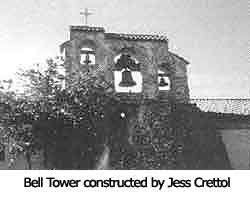 The Crettols made the adobe
bricks and restored the quadrangle
first; then Jesse built the bell tower
at the south end of the mission property; The elder builder, Jess, built
the rock and masonry bell tower adjacent to the mission cemetery;
Previously, the huge bell had been
mounted on a short wooden tower.
The wall in front of the mission was
constructed in 1937.
The Crettols made the adobe
bricks and restored the quadrangle
first; then Jesse built the bell tower
at the south end of the mission property; The elder builder, Jess, built
the rock and masonry bell tower adjacent to the mission cemetery;
Previously, the huge bell had been
mounted on a short wooden tower.
The wall in front of the mission was
constructed in 1937.
In the 1950s, a new wing and a wall around the south end of the mission were added. The Crettols are also credited with aiding the rebuilding of the Estrella Adobe Church, as well as Mission San Antonio. For all of these projects, Jesse designed and had a Paso Robles blacksmith, Fred Cuendet, build an adobe mud-mixer; the machine, built on a 1931 Chevy chassis, looks like a cross between a truck and a tractor.
Jesse's building was interrupted by World War II. After the war, Jesse returned to San Miguel, and married Lucille Crettol. She had been born on August 16, 1907.
Louise Crettol later related that some of the old adobe bricks that the men found had been made with the bodies of birds inside, used instead of straw: Dan Krieger, history professor at California State Polytechnic University in San Luis Obispo, has stated that San Miguel's adobe bricks ordinarily had ox-blood and horse manure blended with the adobe soil.
[There is a stucco house at 11th and L Streets in San Miguel, which was built by Jess Crettol and his son. It contains a wall which features cement plaques which represent the signs of the zodiac and the four phases of the moon. Also featured is a barbecue pit with a stone chimney in the shape of a dragon; it is designed to release smoke through the dragon's mouth and nostrils when the pit is being used.]
The tennis courts and handball courts were the final projects; they were constructed in the 1960s. Jesse Crettol worked on the mission buildings until 1967; that year, he went to work for San Luis Obispo County Parks and Recreation Department in San Miguel.
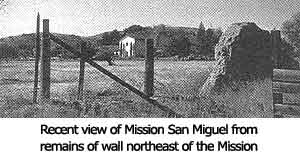 Blanch L. Crettol passed away on February 9,
1958; she was followed in death by her husband, Jess,
on December 15,1958. Jesse Crettol died on May 18,
1989; Lucille Crettol passed away on May 25, 1993.
Blanch L. Crettol passed away on February 9,
1958; she was followed in death by her husband, Jess,
on December 15,1958. Jesse Crettol died on May 18,
1989; Lucille Crettol passed away on May 25, 1993.
The daughter of Jesse and Lucille is Lynne Schmitz. She and her husband, Andrew "Bud" Schmitz, live and work on the property across from the mission; it was once the mission pear orchard and was later a dairy;
This excerpt was used with Author's permission from:
The Lands of Mission San Miguel
by Wallace V. Ohles
Copyright © 1997 The Friends of the Adobes, Inc. All rights Reserved,
A copy of this book may be obtained from the Mission Gift Shop (805) 467 3256.